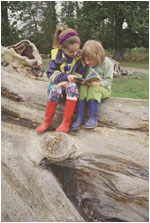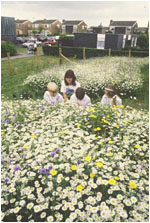|
|
|
 |
|
| Parks and Green Spaces |
| |
 |
If you are fortunate enough to
have a garden or share a communal space with your neighbours,
you are in a position to actively encourage and appreciate wildlife
at close hand. Even a window box or balcony can be planted to
attract butterflies or bees, and a bird nest box, bird bath
or feeder can be attached to almost any outside wall. Wildlife
is all around us, in the middle of our cities as well as in
our countryside. |
 |
|
 |
Having no outside space at all does
not mean you have to miss out on wildlife. Most people have
access to the local park, village green, community garden or
even to the trees that may line our local roads, and there will
be plenty of minibeasts, birds, mammals and amphibians in these
places if we are prepared to look for them. There are many simple
ways of enjoying nature in these places.
You could … |
 |
| |
| 1. |
Have a picnic in the park.
In quieter areas you may see birds and mammals such as
woodpeckers or squirrels, and a pair of binoculars will
bring these animals even closer, allowing you to appreciate
their appearance and activities. There may be butterflies,
bees and hoverflies in any planted areas. A book on wildflowers
will help you to identify plants you find in the wilder
areas, and a hand lens opens up the fascinating world
of minibeasts. |
 |
| 2. |
Feed the ducks in your local
pond or park. |
 |
| 3. |
Try birdwatching. Birds are
adaptable creatures and can be found just about everywhere.
Even once uncommon birds, like peregrine falcons, can
now be found in the heart of some of our large cities.
Most counties have a local ornithological society or wildlife
trust, made up of friendly and enthusiastic people all
too ready to lend a hand to a beginner. Look out for information
in your local paper on organised trips to a nearby reservoir
or green space. |
 |
| 4. |
Visit open gardens. All through
the year, enthusiastic gardeners share their plots with
anyone who has an interest in gardening or the outdoors.
This can be a great way of observing wildlife, especially
birds and insects, and sharing your experiences with others. |
 |
|
| 5. |
Volunteer. Some hospitals
have wildlife gardens maintained by volunteers, and many
cities have an urban wildlife group. Your help and enthusiasm
could be put to good use to make a habitat for wildlife
in your area. If you have a school age child, their school
may have a wildlife garden that is managed on a voluntary
basis by parents. It’s also worth contacting your
local council to see if they have a programme of activities
on local nature reserves. |
 |
| 6. |
Take up an allotment. Allotment
gardening has declined considerably in recent years and
many allotments are now overgrown and neglected. This
is a great way of developing your gardening skills, growing
healthy food organically, getting some exercise and meeting
like-minded people. Contact your local council for information
about vacant allotments. |
|
 |
 |
Whether you have a garden of your
own or not, you may feel you could help to make the area around
your workplace more wildlife-friendly. Something as simple as
seeking permission to put up a bird box or bird table could
help the local bird life, as well as capture the interest of
others who work with you. Where there are trees and shrubs around
office buildings, these are often managed without much thought
about the plants used or the way these area are looked after.
Persuading your employer that shrubs could be pruned less often
could help wildlife and save money. Suggestions for wildlife-friendly
bedding plants or native shrubs may also be appreciated. |
 |
 |
If you want to find out about local
green spaces try your Council website, office or library. Local
parks and greenspaces, cemeteries and nature reserves are increasingly
being made more user-friendly and are a great local resource. |
 |
 |
If you want more information on National
Nature Reserves close to where you live or work, have a look
at ‘nature on the map’ on this website. |
|
| |
| |
|

